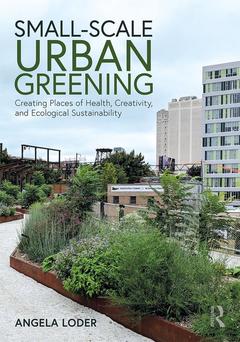Small-Scale Urban Greening Creating Places of Health, Creativity, and Ecological Sustainability

Small-scale urban greening projects are changing the urban landscape, shifting our experience and understanding of greenspaces in our cities. This book argues that including power dynamics, symbolism, and aesthetics in our understanding of the human relationship to urban nature can help us create places that nurture ecological and human health and promote successful and equitable urban communities. Using an interdisciplinary approach to current research debates and new comparative case studies on community perceptions of these urban greening projects and policies, this book explores how small-scale urban greening projects can impact our sense of place, health, creativity, and concentration while also being part of a successful urban greening program. Arguing that wildness, emotion, and sense of place are key components of our human?nature relationship, this book will be of interest to designers, academics, and policy makers.
Introduction: Re-imagining the city: urban greening as creative solution to social and ecological challenges
Chapter 1: Nature, Health, Well-being and Sense of Place: what do we know? What don’t we agree on?
Biological paradigm: adaptive and utility
The Social Construction Paradigm: constructed, political, and relational
New directions in nature, health, and well-being research
Moving forward: research, policy, and practice on nature and health in cities
Chapter 2: Ecology in the margins: Green Infrastructure and stormwater management
Introduction
Ecosystem services, green infrastructure, and stormwater: a short history of re-thinking water in cities
City-wide approaches to urban greening and stormwater: the case of Philadelphia
Piece-by-piece layering and conversion: urban greening and stormwater in Toronto
Small-scale urban greening and green infrastructure: reflections
Links to research and moving forward
Chapter 3: Meadows in the sky: a green roof case study
Introduction
What do we know about green roofs, health, and well-being?
Methods
Results: what did they think and feel about green roofs?
Implications for policy, research, and the human relationship to nature
Asking the same questions in a different way: a survey
Lessons learned from quantitative versus qualitative methods
Conclusion
Chapter 4: Reclaiming the city: vacant lots and post-industrial corridors
Introduction
Marginal spaces: regreening neglected areas
Case studies: Chicago and Philadelphia
Chicago and vacant lots
Vacant lots: Philadelphia
Post-industrial urban greening: elevated parks
Case study: Philadelphia’s Rail Park
Case study: Chicago’s The 606
Small-scale urban greening, interstitial, and post-industrial space: reflections and moving forward
Research and the real-world: opportunities for collaboration and change
Conclusion: Policy lessons and Research Implications: Connecting urbanites to nature and re-thinking urban greenspace
Introduction
Policy
Review of case study conclusions
Lessons learned, looking ahead
Frame the issue
Governance, funding, and legislation
Tactical urbanism, community outreach, and research
A way forward: learning by doing, adaptive planning
Research context
How do we value urban nature as experienced with SSUG projects?
How we experience SSUG: implications for research
Education and design implications for health, well-being, and ecological sustainability
Looking ahead
Angela Loder is Vice President, Research, for the International WELL Building Institute. In this role she is responsible for identifying, directing, and managing evidenced-based research that supports the WELL Building Standard. She has been a core member of the Health in Buildings Roundtable (HiBR) with the National Institutes of Health since 2009. She is a Canada-U.S. Fulbright Scholar, a board member of the Institute for the Built Environment at Colorado State University, Adjunct Faculty at the University of Denver, and part of the first cohort of WELL Faculty and a WELL AP. She holds a collaborative PhD in Health and Urban Geography and Environmental Studies from the University of Toronto.
Date de parution : 03-2020
17.4x24.6 cm
Disponible chez l'éditeur (délai d'approvisionnement : 14 jours).
Prix indicatif 160,25 €
Ajouter au panierDate de parution : 03-2020
17.4x24.6 cm
Disponible chez l'éditeur (délai d'approvisionnement : 14 jours).
Prix indicatif 68,20 €
Ajouter au panierThèmes de Small-Scale Urban Greening :
Mots-clés :
Urban Greening Projects; green walls; Urban Greening; ecosystem services; GI; green urban spaces; Urban Greening Policies; biophilic design; Green Roofs; nature health; GI Implementation; Urban Greenspace; Philadelphia Water Department; Rail Park; UHI; Green Streets Program; Adaptive Paradigm; MEC; Social Constructionist Paradigm; GI Project; Van Der Jagt; Research Programs; Urban Greening Initiatives; Utilitarian Paradigms; GI Initiative; Exhaustion Disorder; Tactical Urbanism; Region Conservation Authority; Center City District; Public Greenspace



